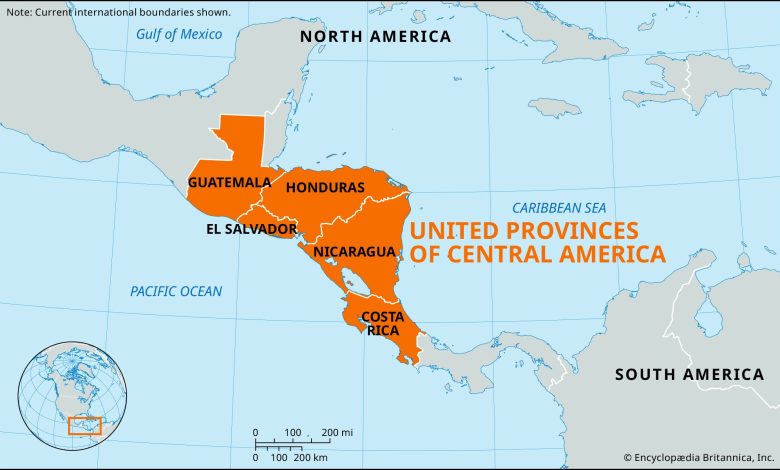Detailed Introduction to the Country of Central American Federation: Discover History

Welcome to our detailed introduction to the Central American Federation. This article will take you on a journey through its history, culture, geography, and key cities. Get ready to explore this fascinating region!

Credit: www.britannica.com
History of the Central American Federation
The Central American Federation was formed in 1823. It united five countries: Guatemala, El Salvador, Honduras, Nicaragua, and Costa Rica. This union aimed to create a stronger, unified region.
The federation faced many challenges. Internal conflicts and political differences led to its dissolution in 1838. Despite its short existence, the federation left a lasting impact on the region.
Formation And Early Years
The Central American Federation formed after independence from Spain. Leaders wanted to create a united region. They believed unity would bring strength and stability.
In 1824, the federation adopted its constitution. The capital city was Guatemala City. The federation faced challenges from the start. Political differences and power struggles were common.
Dissolution And Legacy
By 1838, the federation dissolved. Internal conflicts and lack of unity led to its end. The five countries became independent nations.
The Central American Federation’s legacy lives on. It inspired future efforts for regional unity. The idea of a united Central America still holds significance today.
Geography of the Central American Federation
The Central American Federation covered a diverse region. It included mountains, volcanoes, and rainforests. The region also had beautiful coastlines along the Pacific Ocean and the Caribbean Sea.
Mountains And Volcanoes
The region has many mountains and volcanoes. Some are active, while others are dormant. These natural features shape the landscape and climate.
Mountains provide stunning views and hiking opportunities. Volcanoes attract tourists and scientists. They study the region’s unique geology.
Rainforests And Wildlife
Rainforests cover much of the Central American Federation. These lush forests are home to diverse wildlife. Visitors can see monkeys, birds, and exotic plants.
Rainforests play a vital role in the environment. They help regulate the climate and provide oxygen. Conservation efforts aim to protect these valuable ecosystems.
Coastlines And Beaches
The federation’s coastlines are stunning. The Pacific Ocean and the Caribbean Sea offer beautiful beaches. Visitors can enjoy swimming, snorkeling, and relaxing on the sand.
Coastal areas are also important for the economy. Fishing and tourism provide jobs and income. The region’s beaches attract visitors from around the world.

Credit: www.bbc.com
Culture of the Central American Federation
The Central American Federation had a rich cultural heritage. It combined indigenous traditions with Spanish influences. This blend created a unique and vibrant culture.
Indigenous Traditions
Indigenous peoples have lived in the region for thousands of years. They have their own languages, customs, and beliefs. These traditions still influence the culture today.
Many indigenous communities continue to practice their customs. They celebrate festivals, create art, and share their history. Visitors can learn about these rich traditions.
Spanish Influences
Spanish colonization brought new influences to the region. The Spanish language and Catholic religion became dominant. These influences shaped the culture and society.
Spanish architecture and art can be seen in cities and towns. Many buildings have a colonial style. Festivals and holidays often have Spanish roots.
Music And Dance
Music and dance are important in Central American culture. Traditional music includes marimba, salsa, and merengue. These lively rhythms are enjoyed by many.
Dances are often performed at festivals and celebrations. They showcase the region’s rich cultural heritage. Visitors can join in and experience the joy of the local culture.
Key Cities in the Central American Federation
The Central American Federation had several important cities. These cities were centers of politics, culture, and economy. Let’s explore some of the key cities.
Guatemala City
Guatemala City was the capital of the federation. It remains the capital of Guatemala today. The city is a hub of politics, culture, and industry.
Visitors can explore historical sites and museums. The city offers a mix of modern and colonial architecture. It’s a vibrant place with much to see and do.
San Salvador
San Salvador is the capital of El Salvador. It’s known for its beautiful landscapes and rich history. The city is an important cultural and economic center.
Visitors can enjoy parks, museums, and markets. San Salvador offers a glimpse into the country’s past and present. It’s a dynamic city with much to offer.
Tegucigalpa
Tegucigalpa is the capital of Honduras. It sits in a valley surrounded by mountains. The city is known for its colonial architecture and vibrant culture.
Visitors can explore historical sites and enjoy local cuisine. Tegucigalpa is a lively city with a rich cultural heritage. It’s a great place to experience Honduran culture.
Managua
Managua is the capital of Nicaragua. It’s the largest city in the country. The city is an important political, cultural, and economic center.
Visitors can explore lakes, parks, and historical landmarks. Managua offers a mix of natural beauty and urban life. It’s a unique city with much to discover.
San José
San José is the capital of Costa Rica. It’s known for its friendly people and beautiful landscapes. The city is a hub of culture, education, and commerce.
Visitors can enjoy museums, theaters, and markets. San José offers a rich cultural experience. It’s a welcoming city with much to explore.
Unique Attractions in the Central American Federation
The Central American Federation had many unique attractions. These sites offer a glimpse into the region’s history and natural beauty. Let’s explore some of the top attractions.
Tikal
Tikal is an ancient Mayan city in Guatemala. It’s one of the largest archaeological sites in the world. Visitors can explore temples, palaces, and plazas.
Tikal is a UNESCO World Heritage site. It offers a fascinating look into Mayan civilization. The site is surrounded by lush rainforest, adding to its beauty.
Lake Atitlán
Lake Atitlán is a stunning lake in Guatemala. It’s surrounded by volcanoes and traditional villages. The lake is known for its natural beauty and serene atmosphere.
Visitors can enjoy boating, hiking, and exploring local culture. Lake Atitlán is a popular destination for nature lovers. It’s a place of peace and tranquility.
Copán
Copán is an ancient Mayan city in Honduras. It’s known for its intricate stone carvings and sculptures. The site offers a glimpse into Mayan art and architecture.
Visitors can explore temples, plazas, and ball courts. Copán is a UNESCO World Heritage site. It’s a must-visit for history enthusiasts.
Arenal Volcano
Arenal Volcano is an active volcano in Costa Rica. It’s one of the most popular attractions in the country. The volcano offers stunning views and adventure activities.
Visitors can enjoy hiking, hot springs, and wildlife watching. Arenal Volcano is a top destination for adventure seekers. It’s a place of natural wonder and excitement.
Ometepe Island
Ometepe Island is located in Lake Nicaragua. It’s formed by two volcanoes, Concepción and Maderas. The island is known for its natural beauty and unique landscapes.
Visitors can explore beaches, forests, and archaeological sites. Ometepe Island offers a mix of adventure and relaxation. It’s a hidden gem in Nicaragua.
Frequently Asked Questions
What Is The Central American Federation?
The Central American Federation was a union of Central American states from 1823 to 1841.
Which Countries Formed The Federation?
The Federation included Costa Rica, El Salvador, Guatemala, Honduras, and Nicaragua.
Why Did The Federation Dissolve?
Internal conflicts and regional disputes led to the dissolution in 1841.
What Was The Federation’s Capital?
Guatemala City served as the capital of the Central American Federation.
Conclusion
The Central American Federation was a unique and fascinating region. Its history, culture, and geography continue to captivate people. The legacy of the federation lives on in the independent nations.
We hope you enjoyed this detailed introduction to the Central American Federation. There’s so much to explore and discover in this vibrant region. Thank you for joining us on this journey!




